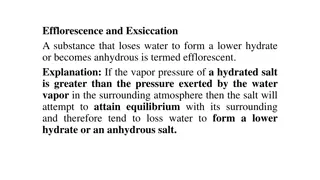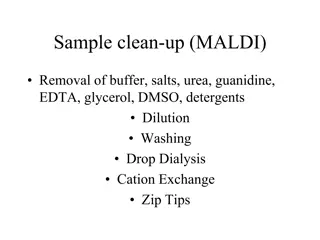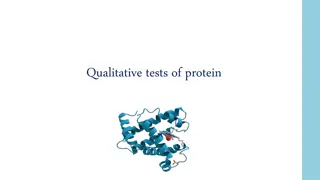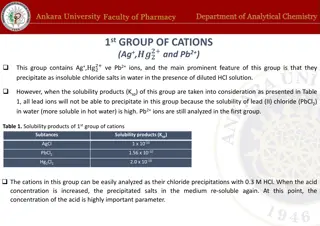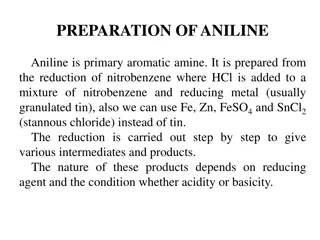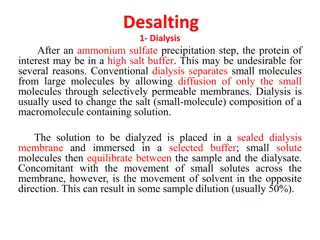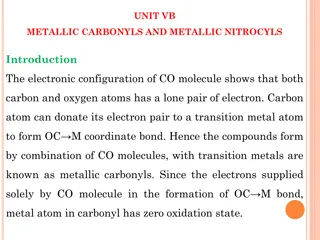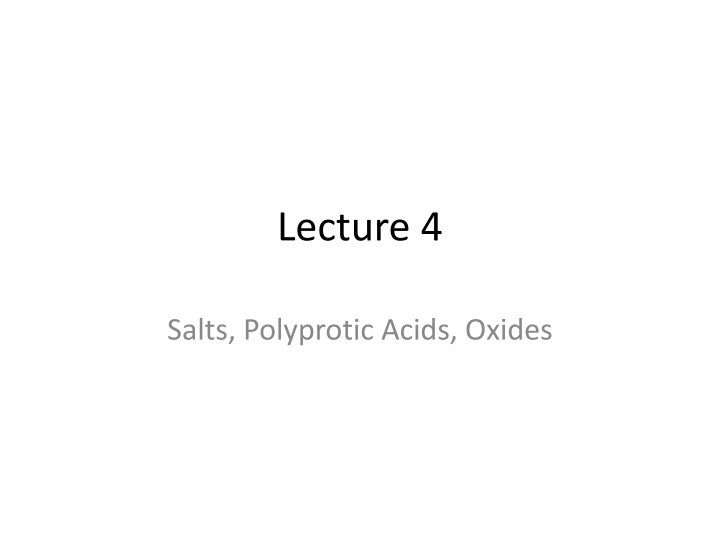
Salts, Polyprotic Acids, and Oxides in Chemistry
Explore the concepts of salts, polyprotic acids, and oxides in chemistry through lectures on pH scale, weak bases, monoprotic acids, and calculating pH of salt solutions. Understand the relationship between conjugate acid-base pairs and the equilibrium constant, Ka x Kb = Kw. Discover the pH values of common substances and learn to calculate the pH of different salt solutions using given Ka and Kb values.
Download Presentation

Please find below an Image/Link to download the presentation.
The content on the website is provided AS IS for your information and personal use only. It may not be sold, licensed, or shared on other websites without obtaining consent from the author. If you encounter any issues during the download, it is possible that the publisher has removed the file from their server.
You are allowed to download the files provided on this website for personal or commercial use, subject to the condition that they are used lawfully. All files are the property of their respective owners.
The content on the website is provided AS IS for your information and personal use only. It may not be sold, licensed, or shared on other websites without obtaining consent from the author.
E N D
Presentation Transcript
Lecture 4 Salts, Polyprotic Acids, Oxides
Lecture Room for Next Week There is a conference in Noyes Lab next week, so we have been kicked out of 100 Noyes Lab for the 1 pm lecture. The room for lecture next week is 2233 Everitt.
Figure 14.6: The pH Scale and pH Values of Some Common Substances (p. 84) H+(aq) + OH-(aq) H2O(l) Kw = [H+][OH-] = 1.0 x 10-14 Bases add OH- to water. A basic solution has: large [OH-], so small [H+] low pOH, so high pH pH = -log[H+] pOH = -log[OH-] pH + pOH = 14.00 Acids add H+ to water. An acidic solution has: large [H+], so small [OH-] low pH, so high pOH
Values for Kb for Some Common Weak Bases (p. 81) Example Kb reaction for C5H5N, Kb = 1.7 x 10-9: C5H5N(aq) + H2O(l) OH-(aq) + C5H5NH+(aq)
Values for Ka for Some Common Monoprotic Acids (p. 81) Example Ka reaction for HNO2, Ka = 4.0 x 10-4: HNO2(aq) + H2O(l) or: HNO2(aq) H3O+(aq) + NO2-(aq) H+(aq) + NO2-(aq)
Calculating the pH of Salt Solutions (p. 92) Calculate the pH of the following solutions: A.0.20 M NaF B. 0.15 M NH4NO3 C. 0.78 M CaCl2 Given: Ka for HF = 7.2 x 10-4 Kb for NH3 = 1.8 x 10-5
pH of Salt Solutions pH of Conjugate Acids and Conjugate Bases Conjugate acid-base pairs: pairs of substances that only differ by a proton (H+) in their formulas, e.g., HCl and Cl- or NH4+ and NH3. For all conjugate acid-base pairs: Ka x Kb = Kw (At 25oC, Kw = 1.0 x 10-14)
Acids and Conjugate Bases (p. 84) Ka Acid Conjugate Base Kb ~10-3 HF ~10-5 HC2H3O2 ~10-11 HOI For all conjugate acid-base pairs, Ka x Kb = Kw = 1.0 x 10-14. Use it to fill in the table.
Bases and Conjugate Acids (p. 84) Kb Base Conjugate Acid Ka ~10-5 NH3 ~10-8 HONH2 ~10-10 C6H5NH2 For all conjugate acid-base pairs, Ka x Kb = Kw = 1.0 x 10-14. Use it to fill in the table.
Acids and Conjugate Bases Ka Acid Conjugate Base Kb = Kw/Ka Kb = 10-14/Ka ~10-11 ~10-3 F- HF ~10-5 C2H3O2- ~10-9 HC2H3O2 ~10-11 OI- ~10-3 HOI The conjugate base of a weak acid is a weak base. The weaker the acid, the stronger the conjugate base.
Values for Ka for Some Common Monoprotic Acids (p. 81) Example Ka reaction for HNO2, Ka = 4.0 x 10-4: HNO2(aq) + H2O(l) or: HNO2(aq) H3O+(aq) + NO2-(aq) H+(aq) + NO2-(aq)
Bases and Conjugate Acids Kb Base Conjugate Acid Ka = Kw/Kb Ka = 10-14/Kb ~10-9 ~10-5 NH4+ NH3 ~10-8 HONH3+ ~10-6 HONH2 ~10-10 C6H5NH3+ ~10-4 C6H5NH2 The conjugate acid of a weak base is a weak acid. The weaker the base, the stronger the conjugate acid.
Values for Kb for Some Common Weak Bases (p. 81) Example Kb reaction for C5H5N, Kb = 1.7 x 10-9: C5H5N(aq) + H2O(l) OH-(aq) + C5H5NH+(aq)
Lecture Question (p. 94a) Consider the following solutions: 0.20 M NaF, 0.15 M NH4NO3, 0.78 M CaCl2 Place these solutions in order of increasing pH. a. NaF < NH4NO3 < CaCl2 b. NaF < CaCl2 < NH4NO3 c. NH4NO3 < CaCl2 < NaF d. NH4NO3 < NaF < CaCl2 e. CaCl2 < NaF < NH4NO3 Hint: Weak gives you weak and strong gives you garbage.
Lecture Question Consider the following solutions: 0.20 M NaF, 0.15 M NH4NO3, 0.78 M CaCl2 Place these solutions in order of increasing pH. a. NaF < NH4NO3 < CaCl2 b. NaF < CaCl2 < NH4NO3 c. NH4NO3 < CaCl2 < NaF acidic neutral basic d. NH4NO3 < NaF < CaCl2 e. CaCl2 < NaF < NH4NO3 Hint: Weak gives you weak and strong gives you garbage.
Question (p. 94a) Are the following salts acidic, basic, or neutral? NH4C2H3O2 HONH3OI C6H5NH3F
Values for Kb for Some Common Weak Bases (p. 81) Example Kb reaction for C5H5N, Kb = 1.7 x 10-9: C5H5N(aq) + H2O(l) OH-(aq) + C5H5NH+(aq) From Appendix A5.3, HONH2 has Kb = 1.1 10 8.
Values for Ka for Some Common Monoprotic Acids (p. 81) Example Ka reaction for HNO2, Ka = 4.0 x 10-4: HNO2(aq) + H2O(l) or: HNO2(aq) H3O+(aq) + NO2-(aq) H+(aq) + NO2-(aq) From Appendix A5.2, HOI has Kb = 2 10 11.
Question Are the following salts acidic, basic, or neutral? NH4C2H3O2 NH4+ + C2H3O2- wk acid + wk base HONH3OI HONH3+ + OI- wk acid + wk base C6H5NH3F C6H5NH3+ + F- wk acid + wk base
Qualitative Prediction of pH for Solutions of Salts for Which Both Cation and Anion Have Acidic or Basic Properties
Question Are the following salts acidic, basic, or neutral? NH4C2H3O2 NH4+ + C2H3O2- wk acid + wk base HONH3OI HONH3+ + OI- wk acid + wk base C6H5NH3F C6H5NH3+ + F- wk acid + wk base
Bases and Conjugate Acids Kb Base Conjugate Acid Ka = Kw/Kb Ka = 10-14/Kb ~10-9 ~10-5 NH4+ NH3 ~10-8 HONH3+ ~10-6 HONH2 ~10-10 C6H5NH3+ ~10-4 C6H5NH2 The conjugate acid of a weak base is a weak acid. The weaker the base, the stronger the conjugate acid.
Acids and Conjugate Bases Ka Acid Conjugate Base Kb = Kw/Ka Kb = 10-14/Ka ~10-11 ~10-3 F- HF ~10-5 C2H3O2- ~10-9 HC2H3O2 ~10-11 OI- ~10-3 HOI The conjugate base of a weak acid is a weak base. The weaker the acid, the stronger the conjugate base.
Question (p. 94a) Are the following salts acidic, basic, or neutral? NH4C2H3O2 NH4+ + C2H3O2- pH=7.0 (Ka=Kb) Ka~10-10 Kb~10-10 HONH3OI HONH3+ + OI- pH>7.0 (Kb>Ka) Ka~10-6 Kb~10-3 C6H5NH3F C6H5NH3+ + F- pH<7.0 (Ka>Kb) Ka~10-4 Kb~10-11
Calculating the pH of Salt Solutions (p. 92) Calculate the pH of the following solutions: A.0.20 M NaF B. 0.15 M NH4NO3 C. 0.78 M CaCl2 Given: Ka for HF = 7.2 x 10-4 Kb for NH3 = 1.8 x 10-5
Lecture Question on Conjugate Acids and Conjugate Bases-p. 87.5 Consider the Ka and Kb values given at the bottom of p. 87.5. Which of the following statements is false? a. The pH of a 1.0 M NaCl solution will be 7.00. b. CN- is a weak base. c. C6H5NH3+ is a weak acid. d. A 1.0 M solution of NO2- will have a higher pH than a 1.0 M solution of CN-. e. A 1.0 M solution of C6H5NH3+ will have a lower pH than a 1.0 M solution of NH4+ .
Lecture Question on Conjugate Acids and Conjugate Bases Consider the Ka and Kb values given on the board. Which of the following statements is false? a. The pH of a 1.0 M NaCl solution will be 7.00. b. CN- is a weak base. c. C6H5NH3+ is a weak acid. d. A 1.0 M solution of NO2- will have a higher pH than a 1.0 M solution of CN-. e. A 1.0 M solution of C6H5NH3+ will have a lower pH than a 1.0 M solution of NH4+ .
Stepwise Dissociation Constants for Several Common Polyprotic Acids
Lecture Question (p. 94a) Consider a 0.10 M H2SO4 solution. What is the correct ordering of species present in this solution from largest to smallest concentration? a. H+ > HSO4- > SO42- b. HSO4- > SO42- > H+ c. H+ > SO42- > HSO4- d. HSO4- > H+ > SO42- e. SO42- > H+ > HSO4-
Lecture Question Consider a 0.10 M H2SO4 solution. What is the correct ordering of species present in this solution from largest to smallest concentration? a. H+ > HSO4- > SO42- b. HSO4- > SO42- > H+ c. H+ > SO42- > HSO4- d. HSO4- > H+ > SO42- e. SO42- > H+ > HSO4-






